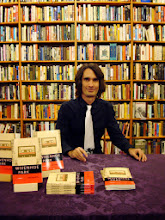If you aren't running as fast as you think you should be, chances are that you are not running enough and that you could also shed a few pounds. Matt Fitzgerald's recent book
Racing Weight has garnered a lot of attention for good reasons. It's an excellent, easy-to-read guide geared towards endurance athletes. Fitzgerald makes specific recommendations for the following sports: running, cross country skiing, rowing, cycling and triathlons.
Before reading
Racing Weight, however, I would definitely check out Pete Magill's article in the most recent issue of
Running Times, entitled "
Why Masters Runners Should Stay Lean." As Magill notes, "The average American male gains a pound a year from age 35 to age 60. Proportionally, women gain even more. We'd like to believe that this weight gain represents increased muscular strength. Or at least excuse it as a byproduct of decreased metabolism. But there's no denying its impact on our running performances."
So how light should you be? Magill provides examples of elite masters runners who still race at their college or even high school weights and also quotes esteemed coach and exercise scientist Tom "Tinman" Schwartz, who states that "A 45-year-old male who adds 10 pounds to his 142-pound frame will lose about 1 minute on a 17:30 5K time." That quote hit home with me as this past fall I was about ten pounds heavier than my high school racing weight (same height more or less) and was racing about 1 minute slower than the Age Grading tables indicated I should have been based on my best AG performances at age 17. Back then my best times fell into the 87-88 range, while now I tend to be in the low 80s.
So what do we do? Fitzgerald recognizes that "In no other sport is a low body weight more beneficial than it is in running. Without a doubt, getting as lean and light as possible without undernourishing their bodies is the greatest weight challenge runners face." Fitzgerald recommends that consistent high volume training is the way to go because it "sends a message to the body that all excess fat stores and even muscle tissue must be thrown overboard for the sake of maximizing running economy." Elsewhere in the book, Fitzgerald provides charts for ideal weight ranges depending on your sport. In general, you should be in the top 80 percentile for body fat proportion.
The chapters on diet are excellent and eye-opening. Fitzgerald provides charts that rank food quality, which makes me never want to crack open a soda or eat a french frie again! Over the past month since reading the book, I have been eating way more whole grains, fruit and veggies, no fried food whatsoever, almost no sugar other than dark chocolate (which seems to be the desert of choice in many of the sample diets of elite athletes that are provided in the book) and I've been feeling much more energetic. I've also been taking peanut butter and jelly sandwiches to work as snacks so I won't succumb to the endless amounts of baked goods that people bring in.
Right now I'm about five pounds lighter than I was a month ago and over the last month I've upped my mileage from 40-50 a week to 60-70. One thing I am doing, which Fitzgerald also recommends, is taking a down week now and then. My current pattern is two up weeks of 60 plus miles followed by a down week of 50. This is the best way to build mileage while also letting your body repair.
Read more...





